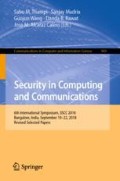Abstract
Low power and lossy networks (LLNs) which are interconnected with internet to collect data through sensors and store them over the cloud make the Internet of Things (IoT). The routing protocols in LLNs play the essential role of forwarding and routing the packets. IPv6 routing protocol for Low power and lossy networks (RPL), used in LLNs has the key features of topology formation, control messages, objective function and Trickle algorithm. The trickle algorithm is a dynamic algorithm controlling the timer in RPL. There are some key parameters in the trickle algorithm that affect the functioning of the trickle timer and consequently the RPL itself. The efficiency, robustness and improvement of RPL depends to a great extent on the fine tuning of the trickle algorithm and there are no specific standard values provided for the attunement. This paper aims at creating a suitable simulation environment in Cooja Simulator over the Contiki operating system and attuning the key parameters of trickle algorithm, namely minimum interval (Imin), maximum interval (Imax) and redundancy value (k) to find out the optimum reliability of RPL.
RPL is expanded asIPv6 Routing Protocol for Low power and lossy networks.
Access this chapter
Tax calculation will be finalised at checkout
Purchases are for personal use only
References
Bharat, T.H.: Network routing protocols in IoT. Int. J. Adv. Electron. Comput. Sci. 4, 29–33 (2017)
Salman, T., Jain, R.: Networking Protocols for Internet of Things, pp. 1–28 (2013)
Atalay, E.W., Anastasi, P.G.: Design and Analysis of Routing Protocol for IPv6 Wireless Sensor Networks (2015)
Xin, H.-M., Yang, K.: Routing protocols analysis for Internet of Things. In: 2015 2nd International Conference on Information Science and Control Engineering, no. i, pp. 447–450 (2015)
Winter, T., et al.: RPL: IPv6 routing protocol for low-power and lossy networks. IETF RFC 6550 (2012)
Levis, P., Patel, N., Culler, D., Shenker, S.: Trickle: a self-regulating algorithm for code propagation and maintenance in wireless sensor networks. In: Proceedings of the First Symposium on Networked Systems Design and Implementation, pp. 15–28 (2004)
Gaddour, O., Koubâa, A.: RPL in a nutshell: a survey. Comput. Netw. 56(14), 3163–3178 (2012)
Vasseur, J.P., Kim, M., Pister, K., Dejean, N., Barthe, D.: Routing metrics used for path calculation in low-power and lossy networks. RFC 6551, Internet Engineering Task Force RFC 6551, March 2012
Al-dubai, A.Y., Altwassi, H., Qasem, M., Yassein, M.B., Al-dubai, A.: Performance evaluation of RPL objective functions performance evaluation of RPL objective functions. In: International Workshop on Internet of Things Smart Spaces: Applications, Challenges and Future Trends in conjunction with 14th IEEE International Conference on Ubiquitous Computing and Communication (IUCC 2015), Liverpool, UK, September 2015
Ali, H.: A performance evaluation of RPL in Contiki, pp. 1–91. Master Thesis (2012)
Becker, M.: Evaluation of an algorithm used in routing and service discovery protocols of wireless sensor networks − the Trickle algorithm IETF protocol stack for wireless sensor networks routing protocol for low power and lossy networks, October 2012
Djamaa, B., Richardson, M., Djamaa, B., Richardson, M.: The Trickle Algorithm: issues and solutions the Trickle algorithm: issues and solutions, January 2015
Ghaleb, B., Al-dubai, A., Ekonomou, E.: E-Trickle: enhanced Trickle algorithm for low-power and lossy networks. In: Proceedings of the 15th IEEE International Conference on Computing and Information Technology (CIT 2015), 14th IEEE International Conference on Ubiquitous Computing and Communications (IUCC 2015), 13th IEEE International Conference on Dependable, Autonomic and Secure Computing, pp. 1123–1129 (2015)
Ghaleb, B., Al-dubai, A., Ekonomou, E., Paechter, B., Qasem, M.: Trickle-Plus: elastic Trickle algorithm for low-power networks and Internet of Things, no. MEIoT, pp. 1–6 (2016)
Djamaa, B., Richardson, M.: Optimizing the Trickle algorithm. IEEE Commun. Lett. 19(5), 819–822 (2015)
Asif, M., Khan, S., Ahmad, R., Sohail, M., Singh, D.: Quality of service of routing protocols in wireless sensor networks: a review. IEEE Access 5(c), 1846–1871 (2017)
Vucinic, M., Tourancheau, B., Duda, A.: Performance comparison of the RPL and LOADng routing protocols in a home automation scenario performance comparison of the RPL and LOADng routing protocols in a home automation scenario, pp. 1974–1979 (2014)
Hendrawan, I.N.R.: Zolertia Z1 energy usage simulation with Cooja simulator, pp. 147–152 (2017)
Mehmood, T.: COOJA network simulator: exploring the infinite possible ways to compute the performance metrics of IOT based smart devices to understand the working of IOT based compression & routing protocols (2017)
Hui, J., Thubert, P.: Compression format for IPv6 datagrams over IEEE 802.15.4-based networks, pp. 5–20. RFC 6282 (2011)
Pradeska, N., Najib, W., Kusumawardani, S.S.: Performance analysis of objective function MRHOF and OF0 in routing protocol RPL IPV6 over low power wireless personal area networks (6LoWPAN). In: Performance Analysis of Objective Function MRHOF and OF0 in Routing Protocol RPL IPV6 Over Low Power Wireless Personal Area Net, October 2016, pp. 0–5 (2016)
Author information
Authors and Affiliations
Corresponding author
Editor information
Editors and Affiliations
Rights and permissions
Copyright information
© 2019 Springer Nature Singapore Pte Ltd.
About this paper
Cite this paper
Charles, A.S.J., Palanisamy, K. (2019). Attunement of Trickle Algorithm for Optimum Reliability of RPL over IoT. In: Thampi, S., Madria, S., Wang, G., Rawat, D., Alcaraz Calero, J. (eds) Security in Computing and Communications. SSCC 2018. Communications in Computer and Information Science, vol 969. Springer, Singapore. https://doi.org/10.1007/978-981-13-5826-5_49
Download citation
DOI: https://doi.org/10.1007/978-981-13-5826-5_49
Published:
Publisher Name: Springer, Singapore
Print ISBN: 978-981-13-5825-8
Online ISBN: 978-981-13-5826-5
eBook Packages: Computer ScienceComputer Science (R0)

